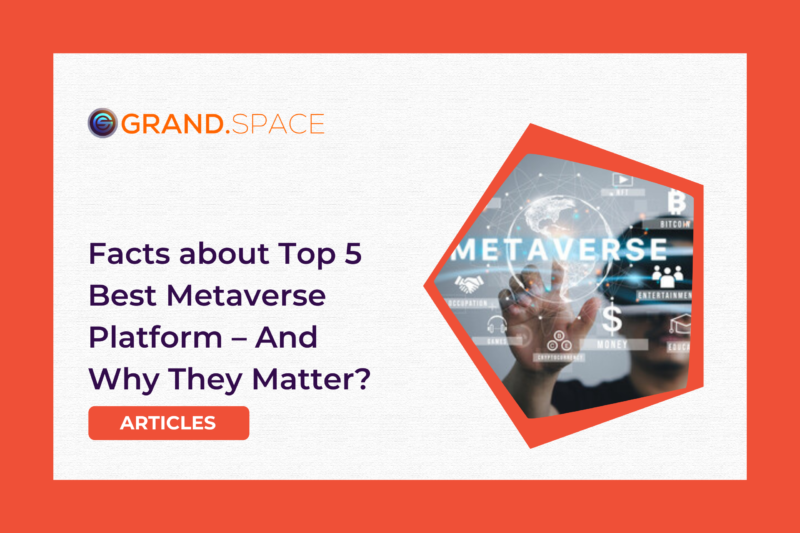With the platforms that have contributed to its development, anyone can access the Metaverse. Metaverse platforms allow virtual reality to become increasingly real, even if the idea is often related to fantasy video games or never-before-seen worlds.
As per Gartner’s research, 25% of the world’s population will spend at least one hour per day in the Metaverse during 2026 for a variety of activities, such as work, shopping, education, social interaction, and entertainment. Four years from now, the Metaverse for events will be part of our daily lives.
Generally, you can enter these ‘new worlds’ for free and create your own avatar. From this perspective, Metaverse platforms are like traditional 2D chat rooms, as users can chat with each other, go for walks, see concerts, attend fashion shows, attend art exhibitions, etc.
Types of Metaverse Platform – Our Top 5 Best Metaverse Platform List
Decentraland
A virtual universe that dates back centuries and has seen a lot of transactions. Today, the platform counts a very long list of brands and a solid community of users that have begun to populate it. Decentraland is a democratic and completely decentralized world based on Blockchain technology; MANA currency holders have the ability to vote on decisions.
Over 800,000 users were registered, and just under 500,000 were active monthly. Getting started in the Decentraland Metaverse is as easy as going to the website, creating an avatar, starting an adventure, and exploring.
The Sandbox
In recent months, The Sandbox has gained popularity as they partnered with Meta. Using NFT and SAND, its avatars can build, own, and monetize using a visual block style. Creators can share and monetize their Ethereum-based voxel creations and game experiences using Sandbox’s decentralized, community-driven gaming ecosystem.
Metaverse platform like Sandboxes are composed of many small platforms connected and interconnected by a large network. A real plot of land can be bought, sold or rented through this platform. Users can create, exchange, buy or sell digital avatars. There is an explosion of colors on the maps graphically. A lively and constantly moving community creates the illusion of being in a world somewhere between Minecraft and Second Life, where creativity is abundant and complex experiences can be created.
Horizon World
A massive hype began when Mark Zuckerberg announced Facebook would change its name to Meta to reflect its increasing investment in wearable technology.
A virtual avatar lets you interact with other users through Horizon Worlds, which is linked to your Facebook account. A world builder is another aspect of the Horizon that enables users to create their virtual spaces according to their needs.
Although it is too soon to determine if Horizon Worlds will become the standard Metaverse platform, it can undoubtedly have a strong start.
Roblox
It has the fastest growth in the metaverse industry and is valued at USD 41 billion. This metaverse platform was established in 2004 and offers a virtual setting for user interaction.
The majority of the games on this platform were made by the users themselves. Making video games has become a way of life for many users; in fact, Roblox may be considered to a sizable repository of “user-generated content.”
The designers of Roblox wanted to provide kids a platform to exercise their imaginations while also introducing them to programming through the creation of individual or group games. Additionally, Craig Donato, chief business officer of Roblox, claims that “unstructured play” is one factor that helps us to taste the success. Unstructured play simply refers to play activities when kids play games without any clear educational goals.
Most of Roblox’s 100 million active members are under the age of 18. The most intriguing and puzzling statistic is that of all the sites, Roblox has the lowest user base (24% of 10 to 12-year-olds use it, more than TikTok and Snapchat).
Spatial
Spatial is one of the best metaverse platform for the following reasons,
- Almost all devices and modes are supported (web, mobile, wearable)
- It places a lot of emphasis on NFTs.
Similar to the other metaverse platforms, Spatial gives you the option to interact in virtual places with your own virtual avatar, which can be personalized starting with a face photo and has a very realistic appearance. Spaces may be found visually or by using a text search, and they are organized by popularity, which correlates to the number of people who are really present in a virtual place.
One of the accessible features of Spatial is NFT artwork where users can view only in the Web version, and can open the related artwork on the OpenSea platform, enabling you to learn more about the artist and ultimately allowing you to purchase the piece.
The experience is substantially better on wearable like the Oculus Quest 2, but your own computer’s technological specifications might also affect how well it runs.
Overall, each of these metaverse platforms results in a satisfying experience. In the upcoming years, a growing number of individuals will be able to live in and experience the Metaverse because of them.
Migrate your Business in Metaverse Platform & Build your own Space
Are you thinking to build own virtual venue in the metaverse platform? With the Grand.Space metaverse platform, you’ll have the foundation for creating a virtual space that consistently meets all industrial demands worldwide.
Grand.Space gives you everything you need to enjoy immersive metaverse worlds that are both enjoyable and interesting. To unlock all the built-in immersive features, subscribe us and before that have a demo of our platform and enjoy giving 3D immersive experience for your audience.
